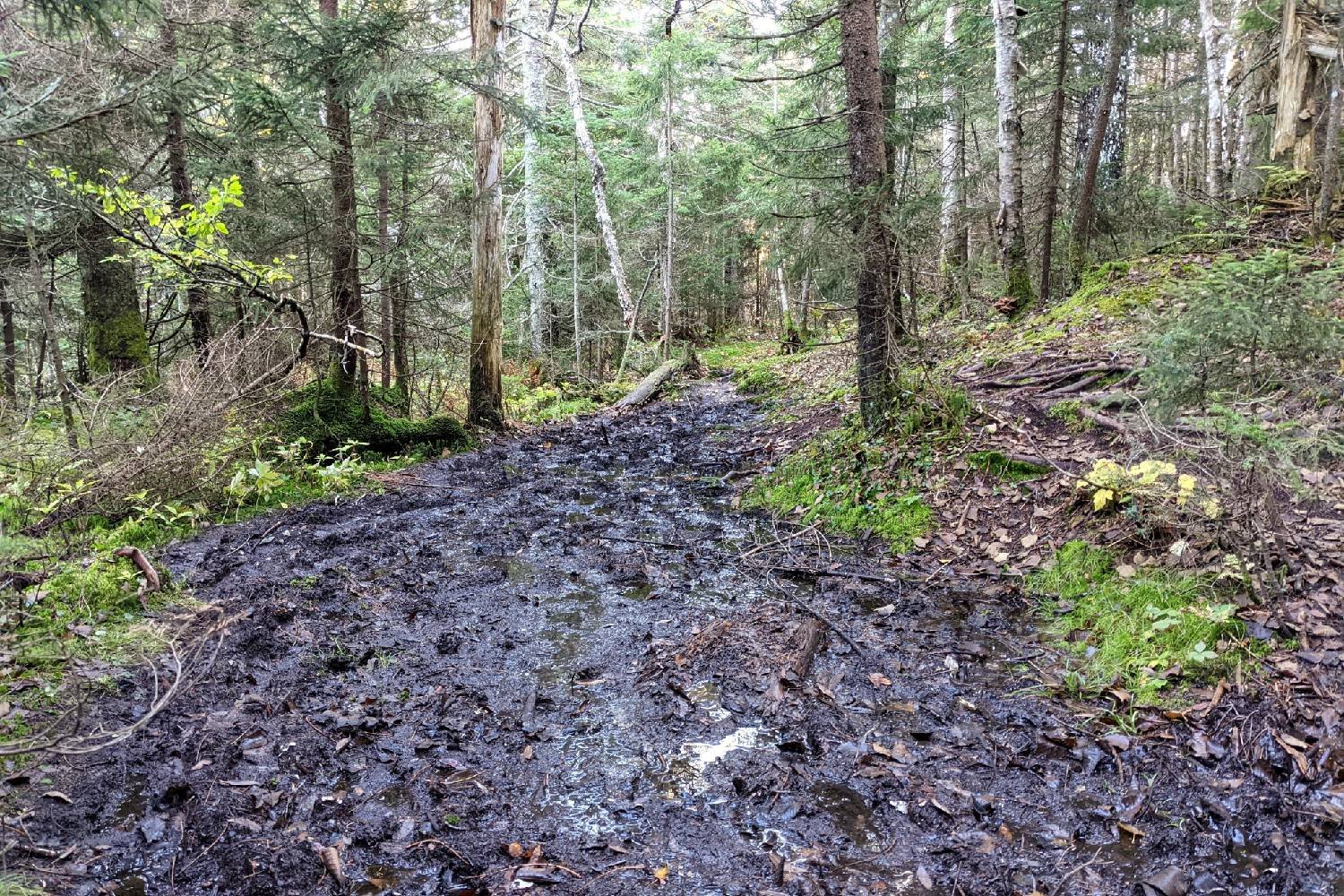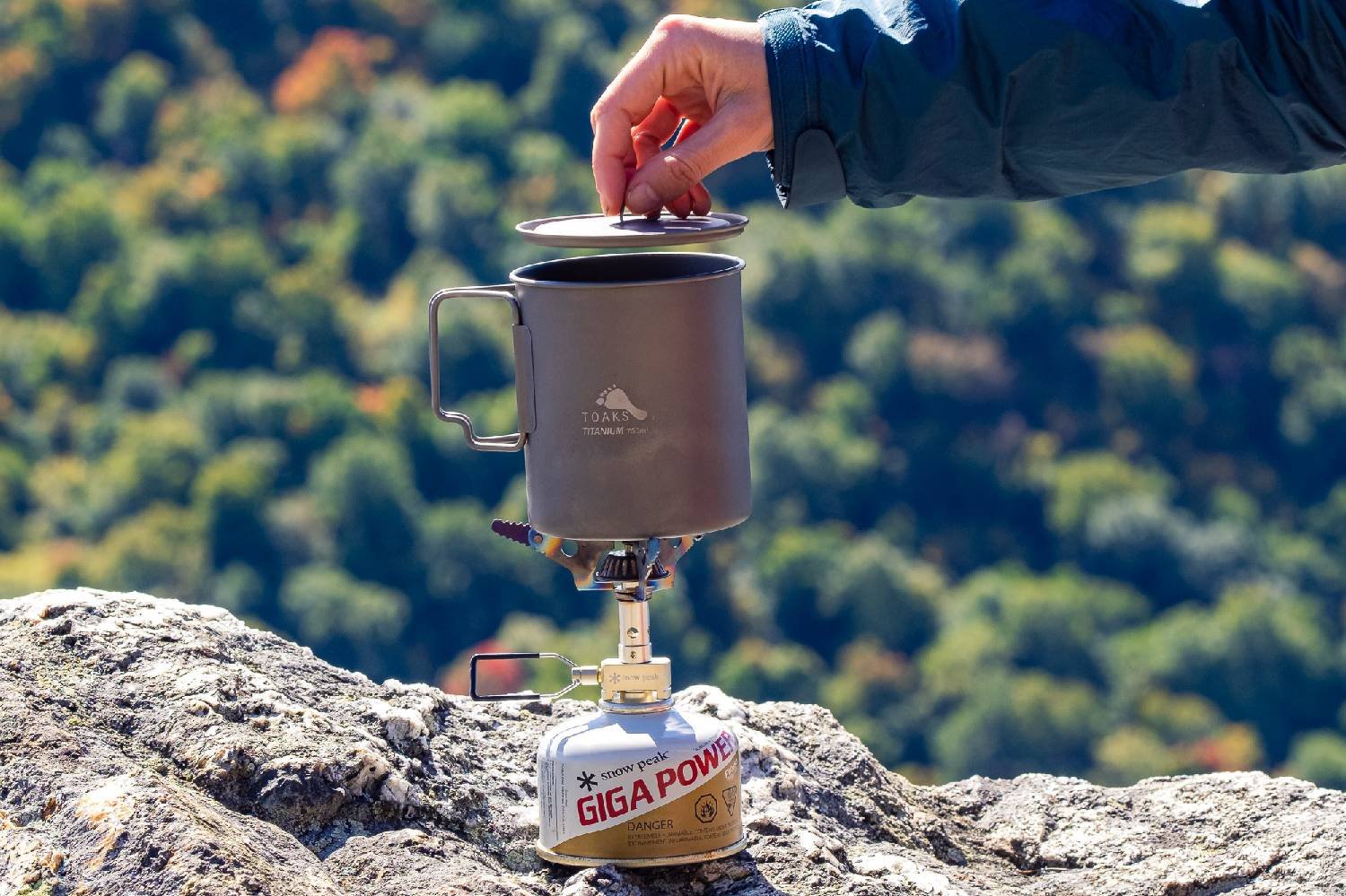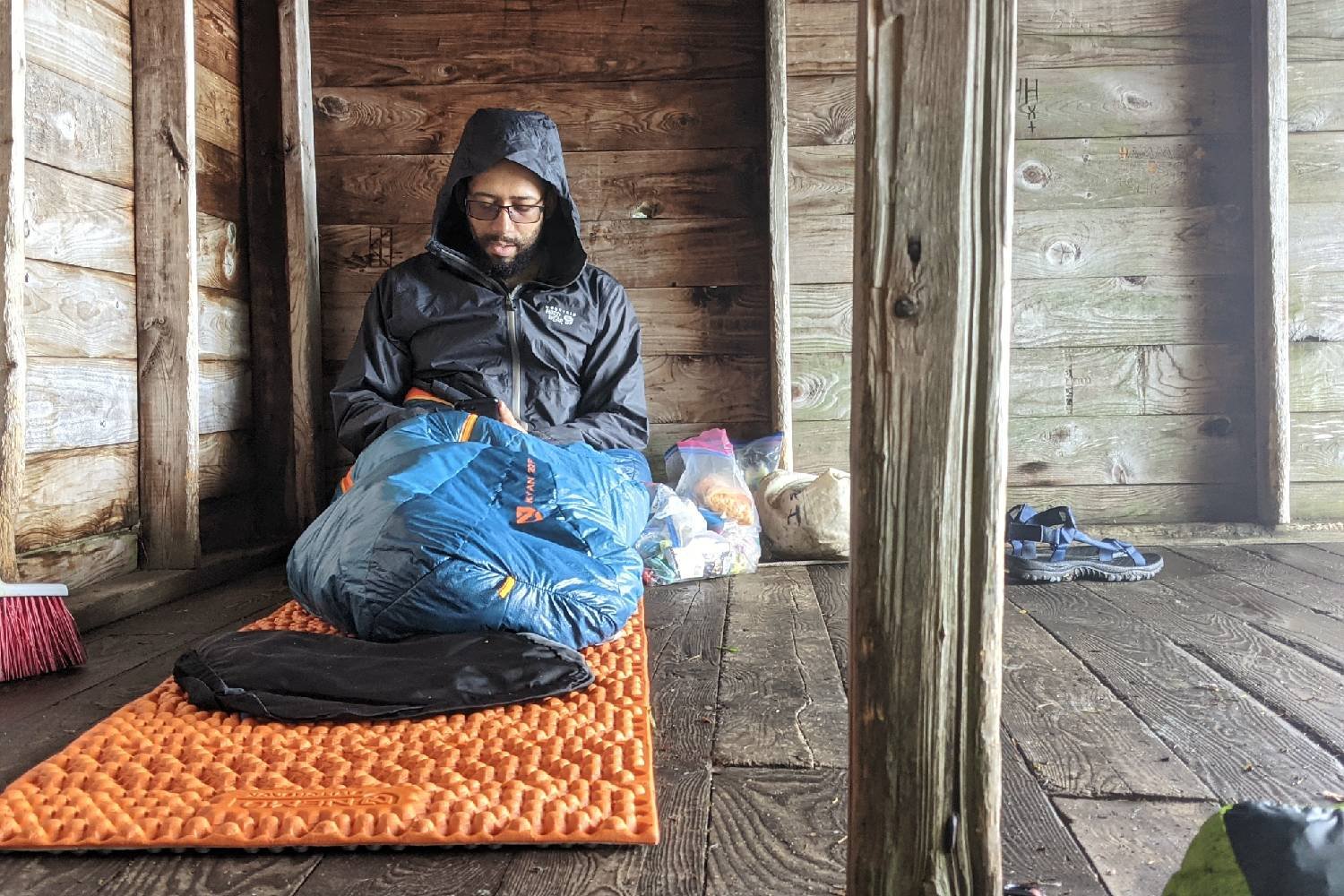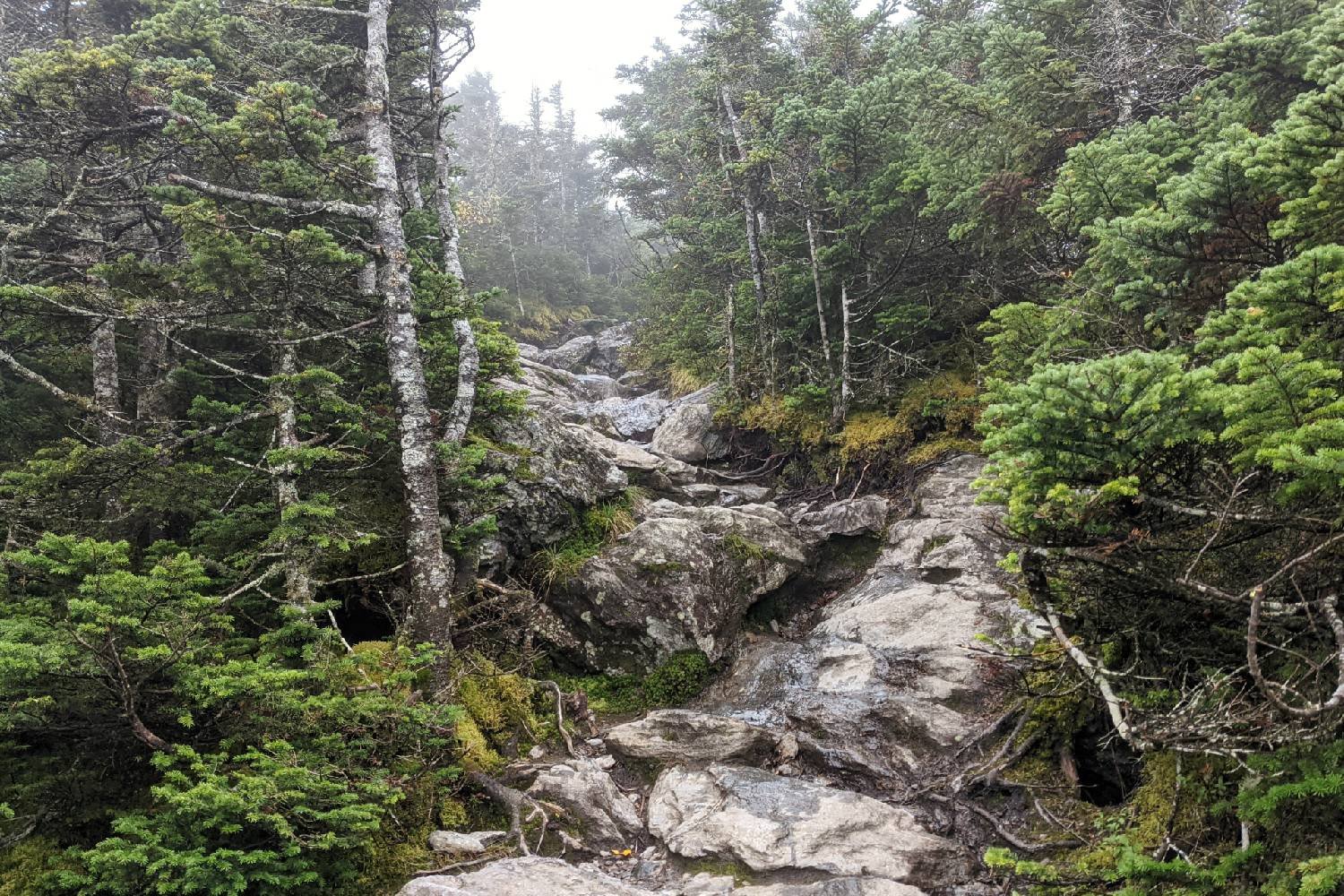
The Long Trail (LT) was the first long-distance trail ever established in America, and it’s also one of the most rugged, with steep ascents and long spells of wet weather. The LT traverses the entire state of Vermont – from the border of Massachusetts to the border of Canada – and hits many of the major peaks in the state.
Every year hundreds of hikers set out to complete an end-to-end hike on this trail, and they’re rewarded with sweeping views of the Green Mountains and White Mountains of New Hampshire, spectacular fall foliage in the later months, and a journey they’ll surely never forget. In this guide, we’ll outline everything you need to know to have a successful hike on the Long Trail.

Quick Facts
- Distance: 272 miles (plus a few extra for the approach trails at the beginning and end)
- Days Needed: 19 to 28 days (seriously fit and experienced hikers may take less time, but you really need to know your limits – this is a very tough trail)
- Peak Elevation: 4,389 ft. – Mt. Mansfield, Vermont’s highest point
- Low Elevation: Around 300 ft.
- Elevation Gain/Loss (approx.): 63,500 ft./63,600 ft (south to north)
- Best Time: June to mid-October (the Green Mountain Club [GMC] requests that hikers start after Memorial Day to avoid the peak of Vermont’s mud season)
- Permits: None
- Difficulty: Strenuous

Highlights
- Well-marked and maintained trail
- Shelters and privies along the entire route
- Frequent road crossings make it easy to resupply or do section hikes
- Dense forest with a lot of unique flora and fauna (bears, moose, owls, mushrooms, berries, etc.)
- Water is plentiful
- Mild temperatures (average highs 70s-80s for the height of summer, 60s for early fall / average lows mid 50s in summer, 40s for early fall)
- If hiking northbound, terrain becomes progressively more difficult, so you get a good warm-up before tackling the toughest mountains
- Social and friendly trail community
- Feeling amazingly capable and confident at the end of the journey
- Summiting Vermont’s highest peaks with beautiful views of the surrounding mountains

Lowlights
- Vermont can be VERY muddy – especially in high snow years
- Strenuous ascents and descents
- Ticks, mosquitos, and black flies can be annoying at times
- Trail can be a little crowded – particularly the first 100 miles, which overlaps with the Appalachian Trail
- Depending on the year, you may encounter long periods (days or weeks) of rainy weather

Best Time to Hike
The Green Mountain Club (GMC), which maintains the Long Trail, requests that hikers wait until after Memorial Day to start their end-to-end hike. This is because snowmelt causes the trails in Vermont to become extremely muddy, and foot traffic during this period can result in substantial erosion. Although it’s possible to hike the LT as early as June, we think it’s best to wait until September. A September start will mean fewer bugs, less mud (although you’ll likely still encounter a ton of mud), avoiding crowds on the AT section, mild temperatures, and beautiful fall foliage.
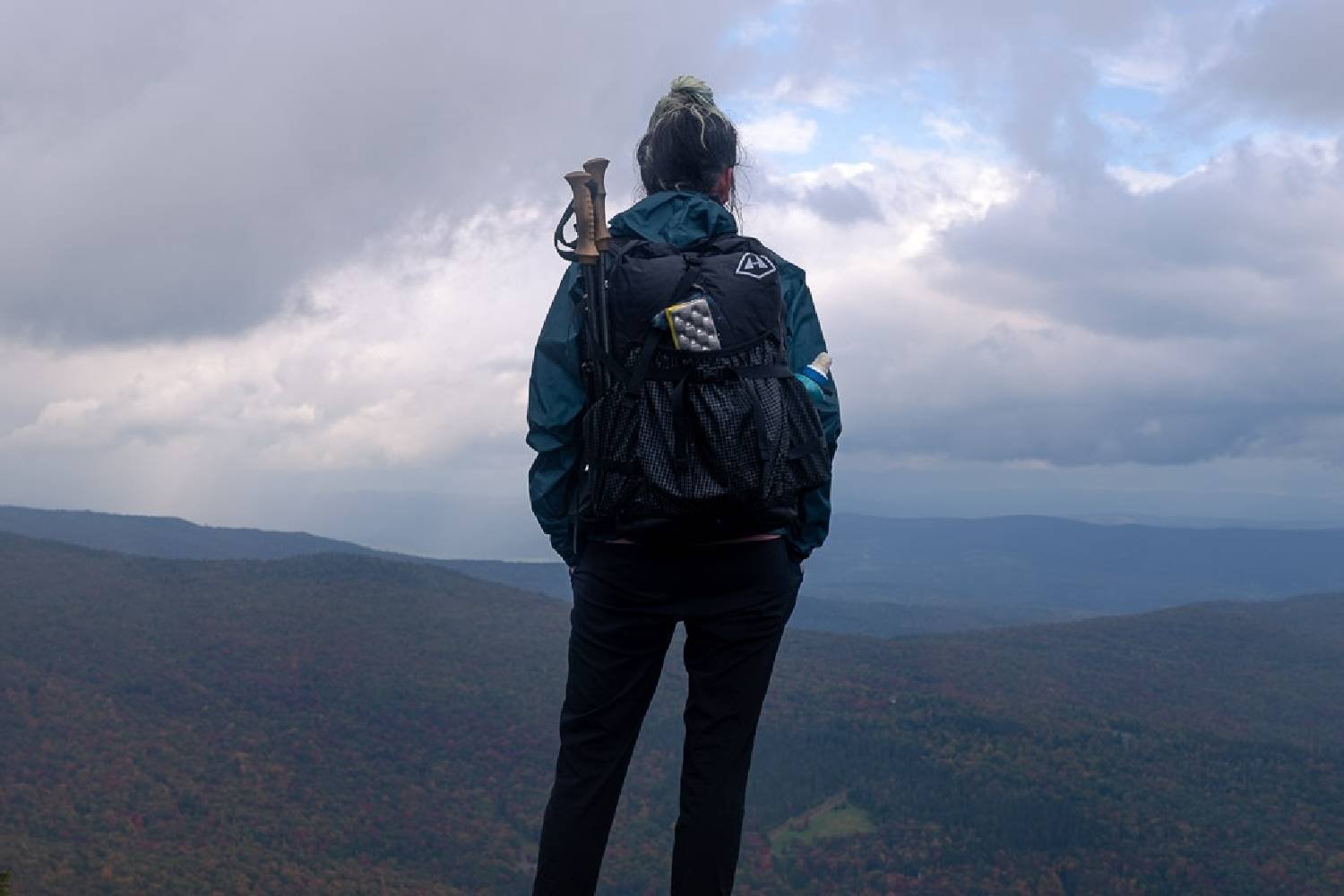
How Long Does It Take?
The average time it takes to complete the Long Trail is about 3-4 weeks. While some very experienced backpackers may be able to hike the trail in less time, the terrain and elevation gain in the Green Mountains make big-mile days pretty difficult. Most people calculate in a few “nero” and “zero” days (rest days) and take the trail at an enjoyable pace.
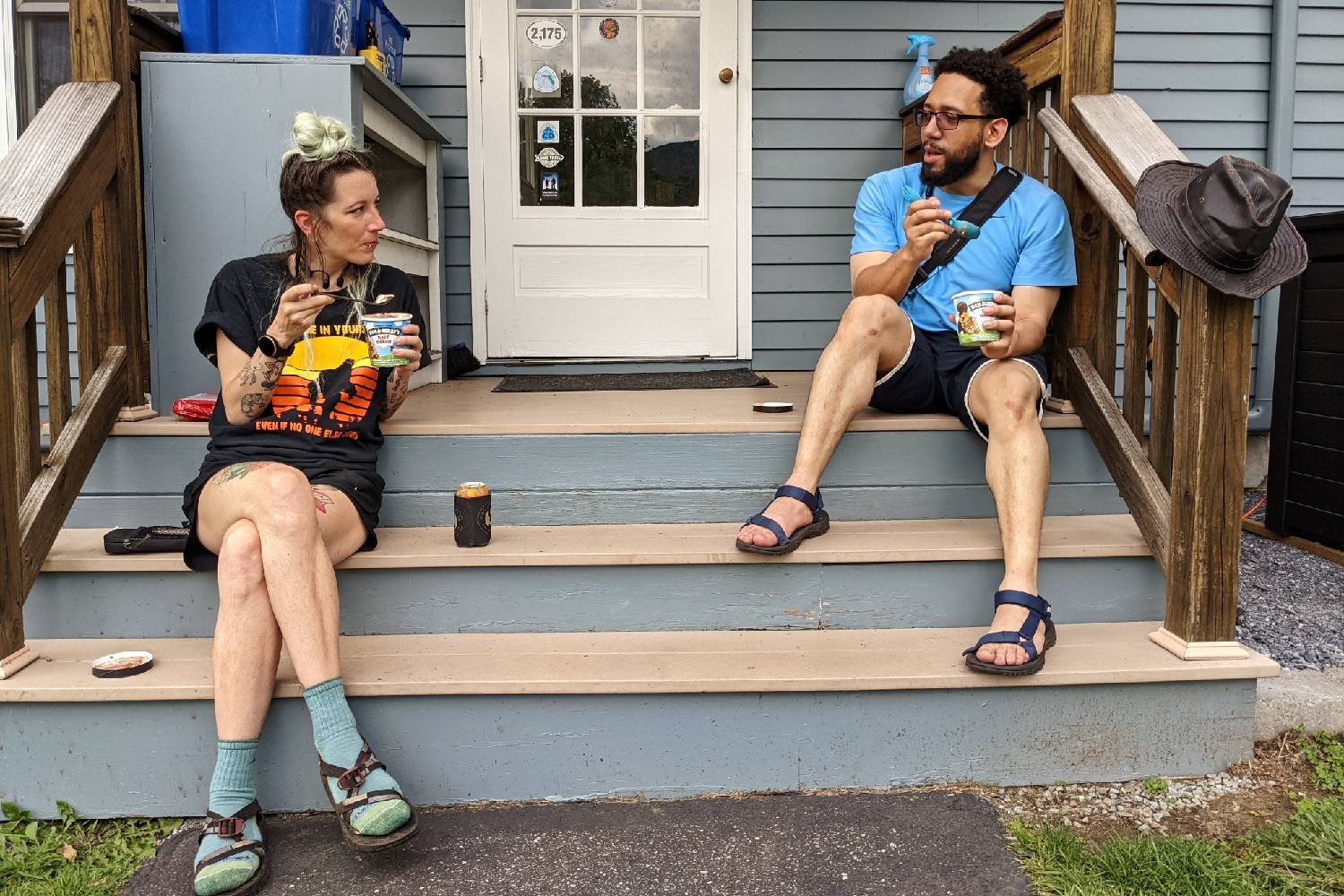
Difficulty
Vermont’s Long Trail is well-maintained, well-marked, and easy to follow, so navigation is rarely an issue. The main difficulties of the LT are the terrain, the steep grade, and the length of the trail.
TERRAIN
The LT can be muddy in all but the driest of years. This means you either have to spend extra time rock-hopping to avoid wet feet, or you trudge straight through and have eternally soggy tootsies. The dry trail miles don’t necessarily mean fast hiking. They are often riddled with roots, loose rock, or slick granite slabs, so the terrain is challenging for the majority of the 272-mile trek.
STEEP GRADES
The ascents and descents on the LT are often steeply graded. It sometimes feels as though the trail goes to great lengths to find you the absolute steepest way up to a peak. In the northern half of the LT, some ascents and descents will feel a lot more like a day at the bouldering gym than a day on a hiking trail. You’ll need to do some hand-over-hand climbing at times, and you’ll have to navigate metal rungs and wooden ladders bolted into sheer rock faces. It’s important to be prepared for the difficulty of these climbs, but they’re very manageable if you take your time. You’ll get to enjoy a great sense of accomplishment every time you’ve finished one of these more challenging peaks.
TRIP LENGTH
Another important thing to think about is the length. Not only is hiking a 272-mile trail a large physical challenge, but it’s also a big time and financial commitment. We typically like to budget $3-$4 per mile for a thru-hike, and we recommend letting your family and workplace know about your plans as far in advance as possible to arrange for time away. Not everyone is able to take time off from their job for so long, nor does everyone have the freedom to step away from commitments. Many people choose to complete the trail in smaller sections.

Permits/Fees
Permits are not required to hike the Long Trail, but there are a few shelters along the way that ask for $5 for overnight stays. This fee goes to the GMC, and it’s used to maintain the dozens of shelters, privies, and campsites along the trail. The fee is waived if you’re a GMC member; we’ll talk a little more about why we recommend becoming a member of the GMC a little later in this guide.
Northbound (NOBO) vs Southbound (SOBO)
Northbound (NOBO) is the more common direction to go on the Long Trail, but a southbound (SOBO) hike also has plenty of benefits. Below we’ll list the main pros and cons of going either direction to help you decide which is best for you.

NOBO
Pros
- The southern terminus is located up a three-mile trail from a well-populated part of Massachusetts – arranging a ride to your starting point is much easier on this end
- The first half is easier hiking than the second half, so you’ll have time to build strength and dial in your gear before the toughest section
- There are more people on the trail to interact with if you’re looking for a social experience
- Ending at the Canadian border can feel more epic than ending at the Massachusetts border
Cons
- The trail and shelters can be crowded, and it may be more difficult to find lodging for rest days in town when you have to compete with all the other NOBOs
- Getting transportation back home from the northern terminus can be tricky
- If you’re starting later in the fall, the weather may get more cold and unpredictable as you get further north

SOBO
Pros
- The trail and shelters are less crowded, and it may be easier to find lodging in town for rest days
- There are more transportation options to get back home from the southern terminus
- Depending on the month you start, you may be hiking in ideal temperatures the whole way down
- You get the challenging parts out of the way first, so the last half may feel more relaxing
Cons
- Less people to interact with if you’re looking for a social experience
- Transportation to the northern terminus can be a bit tricky
- The northern half may feel more difficult for SOBOs because you start with the hardest climbs without getting a 100-mile warm-up

Transportation to Trailheads
NORTHBOUND
If you’re hiking NOBO on the Long Trail, transportation options to the southern terminus are pretty abundant. We found that the most convenient and cheapest airport to fly into was Albany, NY, but some hikers choose to fly into Burlington, VT or other nearby airports. From Albany, we took a cheap Greyhound bus to Bennington, VT, which is about a 20-minute drive from the starting trailhead. Once in Bennington, there are a ton of options for private shuttles. Hitchhiking to the trailhead can also be relatively easy, and some motels (like the Catamount Motel, where we enjoyed a stay) offer rides to the trailhead for paying customers.

SOUTHBOUND
If you’re hiking SOBO, the most ideal situation would be having a friend or family member drop you off at the northern terminus. If that’s not an option for you, your best bet is probably flying into Burlington, VT, then taking a bus to Waterbury, Jefferson, or St. Albans, VT and calling a private shuttle from there. You could do a private shuttle all the way from Burlington, but it’s a long distance, and the added cost may not be worth the time saved.

Planning Your Itinerary
Planning a loose daily itinerary isn’t necessary, but we’ve learned from completing multiple thru-hikes that it’s very helpful. Most people take about three weeks to complete the Long Trail, with many averaging around 10-14 miles a day. That said, very fit and experienced hikers may cover 15-20 miles a day. In general, we always recommend overestimating your time on the trail. You can always get off the trail early, but it’s not as easy to extend beyond your planned finish date if you have obligations to return home to. Your itinerary should take into consideration your ability, personal preferences, hiking style, and zero days (no hiking) you may want to take. The FarOut app is an excellent resource to use when planning your itinerary. It shows how many miles there are between each shelter and the services nearby towns offer. The comments other users left about trails and places they enjoyed visiting are also useful to read.

LONG TRAIL SHELTERS, CAMPSITES & PRIVIES
There are shelters – usually three-sided lean-tos, sometimes fully enclosed cabins – located every 5-10 miles or so along the LT. Most of them are free to stay at (some have a caretaker and ask for a $5 fee to help with maintenance costs), and they all have composting or moldering privies nearby. Many shelters also have a fire pit, a picnic table, and flat ground or platforms for tenting close by. While it is possible to sleep in a shelter every night of your end-to-end hike, you shouldn’t rely solely on them. Shelters can fill up – especially in peak hiking season and during inclement weather – so you should also carry a tent or some other type of shelter with you in case there isn’t room for you inside or if you run into an emergency.

The privies are well-maintained, and many of them have lovely views. Make sure you pack in your own toilet paper, and follow all guidelines posted on the privy door (such as whether or not you can pee in the privy, throw in a handful of wood chips to “flush”, etc.). Be aware that in peak season, privies can also fill up. So it’s a good idea to have a wide tent stake or a trowel with you in case you need to dig a cathole when nature calls. Check out our article, How to Poop in the Woods, to learn proper backcountry bathroom etiquette.
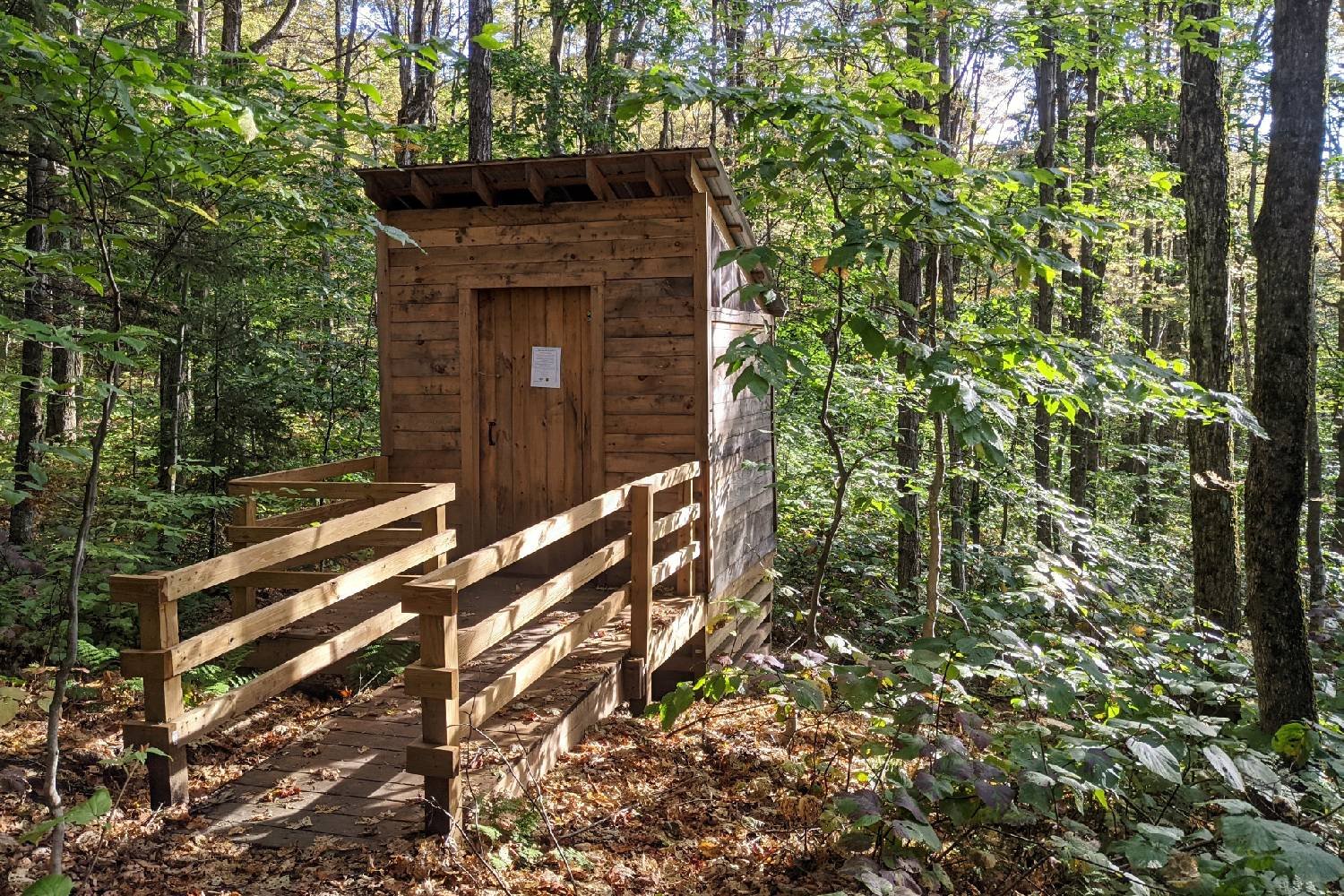
FOOD & RESUPPLY POINTS
Because you’ll be on the trail for a few weeks, you won’t be able to carry all your food in your pack. You’ll need to stop and resupply periodically along the trail. Most people resupply 4-5 times, but you can certainly do more or less depending on how often you want to go into town. Opportunities to get a ride to a grocery store are plentiful throughout most of the trail, so resupplying often is very easy if you want to cut down on food weight in your pack. Just be aware that town stops tend to take up a whole lot of time, so you’ll need to balance the convenience of carrying less food against the time you’ll lose on the trail by making frequent stops.
Many small towns in Vermont have been impacted by recent flooding, so your business is greatly appreciated. The rich and vibrant food and farm culture in Vermont is hard to beat. Even some of the smallest towns have amazing bakeries, breweries, and eateries. Getting a taste of Vermont’s dedication to locally grown, sourced, and made food can be part of the Long Trail experience when you stop into a town for a resupply. Oh, and if you haven’t yet, be sure to have a creemee (it’s a Vermont twist on soft-serve, sweetened with maple syrup) while you’re in the Green Mountain State.

You can resupply by mailing boxes ahead of time to a post office or a place in town that offers to hold boxes for hikers (like a hostel), having a friend or family member meet you at road crossings with fresh supplies (we saw many hikers who traveled with a dog choose this option), or getting a ride into a nearby town for the grocery store. If your resupply plan involves mailing packages, you’ll want to ship them well in advance to make sure they arrive in time for you to pick them up. For mailed resupply boxes to a post office, first, make sure the Post Office in your targeted town accepts general delivery, then address your box with the following: Your Name c/o General Delivery Town Name, VT 01234 Arriving By: ETA It’s also a good idea to write your name or put a special marker (like colorful tape) on all sides of the box to make it easier for postal workers to find it amongst all the other resupply boxes. We chose to shop in towns for all of our resupplies during our hike.
Below are the towns we stopped in:
Manchester Center (LT mile 54.4)
Stay here: Green Mountain House Hiker Hostel – this was one of the cleanest and most hospitable hostels we’ve ever stayed at. The owners, Jeff and Regina Taussig, are hikers themselves, so they know exactly what LT hikers need – like a freezer full of Ben & Jerry’s ice cream pints!
Eat here: Sam’s Woodfired Pizza
Resupply here: Shaws/The Mountain Goat (for gear)

Rutland, VT (LT mile 104.5)
Stay here: Inn at The Long Trail – It’s easy to get here via a short side trail off the Long Trail, or you can catch a free bus to it where the trail crosses Rt. 4. The rooms are cozy and the included breakfast in the morning is amazing. There’s also an Irish Pub inside the inn to grab a drink at and watch live music if that’s your thing. If you need to get into town for the grocery store, it’s easy to hitchhike from here, or you can take the free bus to the town center.
Eat here: Brix Bistro
Resupply here: Price Chopper/Rutland Area Food Co-op (lots of vegan options)

Waitsfield, VT (LT mile 163.7)
Stay here: Swanson Inn – We’re convinced that owners Tim and Rick are some of the nicest folks in the whole state. They offer rides to and from the trail, rides into town for resupply, a fantastic breakfast, and homey rooms inside a beautiful house.
Eat here: Mad Taco/Lawsons Brewery
Resupply here: Shaw’s

Waterbury VT (LT mile 184.6)
We didn’t stay the night in Waterbury, but it’s easy to get to. So we took a trip into town for the grocery store and some town food. Even if you plan to stop in Waitsfield (about 20 miles away), resupplying in both towns will allow you to carry a lighter pack for the tough climb and descent over Camel’s Hump.
Eat here: Blackback
Resupply here: Village Market / Shaw’s / Waterbury Sports (for gear)

Johnson, VT (LT mile 221.6)
Stay here: Nye’s Green Valley Farm – This 1800’s farmhouse B&B is run by Marsha and David Nye. They offer a hiker rate, rides to and from town and the trail, they do your laundry for you, and they feed you an amazing homemade breakfast. This was a very comfortable and friendly place to stay before making the final push north to Journey’s End.
Resupply here: After a destructive flood, Johnson’s Sterling Market permanently closed. The nearest grocery store is in Morrisville (a 15-minute drive from Johnson). The town is hopeful a new grocer will open in the future. / Johnson Hardware & Rental (for gear)

Water
In general, water sources along the LT are plentiful – it’s rare you’ll hike more than a couple hours without hitting one. That said, some streams can go dry during long periods with no rain. Always check your map for water sources, consult with fellow hikers, or use the FarOut app for updates on current conditions. In general, it’s common to hike with no more than two liters at any given time along the LT. Though many of the water sources you’ll find along the LT run clear and appear free of sediment, you’ll still want to filter your water. We used the Katadyn BeFree to filter water on the trail because it’s lightweight, fast, and easy to clean in the field. Another very popular and affordable option that many hikers use on the LT is the Sawyer Squeeze.

Bears & Food Storage
Black bears live in the forests along the entire Long Trail, so it’s important to take steps to keep yourself and these animals safe. Visitors to the Green Mountain National Forest (the majority of the Long Trail) are required to store food and other scented items in a bear box or a bear canister or to bear hang food at least 12 feet from the ground and six feet from any horizontal object. Many of the shelters on the LT have bear boxes nearby for safely storing your food.
Bugs
Ticks, mosquitoes, and black flies can be a nuisance on the Long Trail, especially in the warmer months. Most bugs dissipate by September, making it a nice time to hike. We recommend using a combination of Permethrin on your clothing and bringing a small bottle of DEET or Picaridin Lotion (our choice) for exposed skin if you’re hiking during the peak of summer.
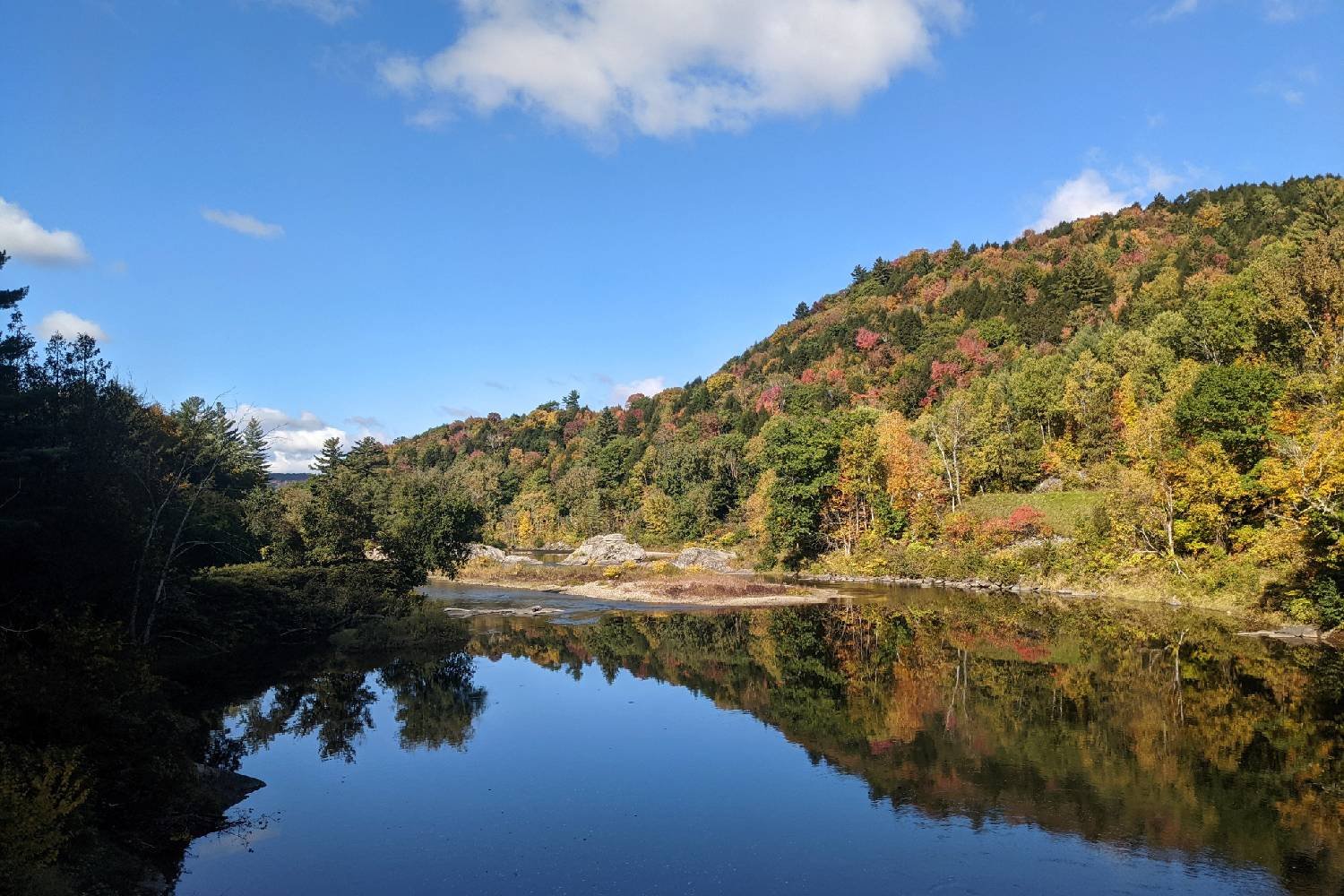
Gear List
Make sure to check out our Ultimate Backpacking Checklist so you don’t forget something important.
Below you’ll find our current favorite backpacking gear. If you want to see additional options, our curated gear guides are the result of many years of extensive research and hands-on testing by our team of outdoor experts.
BACKPACK
- Best Backpacking Pack Overall: REI Flash 55 – Men’s / REI Flash 55 – Women’s
- Best Ultralight Backpacking Backpack: Hyperlite Mountain Gear Unbound 40
- More: Check out our best backpacking backpacks guide for ultralight and trekking options
TENT
- Best Backpacking Tent Overall: Big Agnes Copper Spur HV UL2
- Best Ultralight Tent: Zpacks Duplex
- Best Budget Tent: REI Half Dome SL 2+
- Best Tent Stakes Overall: All One Tech Aluminum Stakes
- More: Check out our best backpacking tents guide for more options
SLEEPING BAG/QUILT
- Best Sleeping Bag Overall: Men’s Feathered Friends Swallow YF 20 / Women’s Feathered Friends Egret YF 20
- Best Quilt Overall: Enlightened Equipment Revelation 20
- More: Check out our best backpacking sleeping bags guide and best backpacking quilts guide for more options
SLEEPING PAD
- Best Sleeping Pad Overall: NEMO Tensor All-Season
- Best Foam Sleeping Pad: NEMO Switchback
- More: Check out our best backpacking sleeping pads guide for ultralight and trekking options
CAMP KITCHEN
- Best Backpacking Stove Overall: MSR PocketRocket 2
- Best Backpacking Cookware Overall: TOAKS Titanium 750ml
- Best Backpacking Coffee Overall: Starbucks VIA
- More: Check out our best backpacking stoves guide and best backpacking cookware guide for ultralight and large group options
WATER & FILTRATION
- Best Water Filter Overall: Sawyer Squeeze
- Best Hydration Bladder Overall: Gregory 3D Hydro
- Best Backpacking Water Bottles: Smartwater Bottles
- More: Check out our best backpacking water filters guide and best backpacking water bottles guide for ultralight and large group options
CLOTHING
- Best Hiking Pants Overall: Men’s Outdoor Research Ferrosi / Women’s The North Face Aphrodite 2.0
- Best Hiking Shorts Overall: Men’s Patagonia Quandary / Women’s Outdoor Research Ferrosi
- Best Women’s Hiking Leggings: Fjallraven Abisko Trekking Tights HD
- Best Rain Jacket Overall: Men’s Patagonia Torrentshell 3L / Women’s Patagonia Torrentshell 3L
- Best Rain Pants: Men’s Patagonia Torrentshell 3L / Women’s Patagonia Torrentshell 3L
- Best Down Jacket Overall: Men’s Patagonia Down Sweater Hoodie / Women’s Patagonia Down Sweater Hoodie
- Best Fleece Jacket Overall: Men’s Patagonia Better Sweater / Women’s Patagonia Better Sweater
- Best Sunshirt Overall: Men’s Outdoor Research Echo / Women’s Outdoor Research Echo
- Best Socks Overall: Men’s Darn Tough Light Hiker Micro Crew / Women’s Darn Tough Light Hiker Micro Crew
- Beste Ultralight Liner Glove: Patagonia Capilene Midweight Liner
- More: Check out our best backpacking apparel lists for more options
FOOTWEAR & TRACTION
- Best Hiking Shoes Overall: Men’s HOKA Speedgoat 6 / Women’s HOKA Speedgoat 6
- Best Hiking Boots Overall: Men’s Salomon X Ultra 4 GTX / Women’s Lowa Renegade GTX
- Best Hiking Sandals Overall: Men’s Chaco Z/1 Classic / Women’s Chaco Z/1 Classic
- Best Camp Shoes Overall: Crocs Classic Clogs
- Best Traction Device for Hiking Overall: Kahtoola MICROspikes
- More: Check out our best backpacking footwear lists for more options
NAVIGATION
- Best GPS Watch Overall: Garmin Instinct 2 Solar
- Best Personal Locator Beacon (PLB): Garmin inReach Mini 2
- More: Check out our article How to Use Your Phone as a GPS Device for Backpacking & Hiking to learn more
FOOD
FIRST-AID & TOOLS
- Best First-Aid Kit Overall: Adventure Medical Kits Ultralight/Watertight .7
- Best Pocket Knife Overall: Kershaw Leek
- Best Multitool Overall: Leatherman Wave+
- Best Headlamp Overall: Black Diamond Spot 400-R
- Best Power Bank Overall: Nitcore NB 10000 Gen 3
- More: Check out our best first-aid Kit guide, best pocket knife guide, best multitool guide, best backpacking headlamps guide, and best power banks guide for more options
MISCELLANEOUS
- Best Trekking Poles Overall: Black Diamond Pursuit
- Best Backpacking Chair Overall: REI Flexlite Air
- Best Backpacking Stuff Sack Overall: Hyperlite Mountain Gear Drawstring
- More: Check out our best trekking poles guide, best backpacking chairs guide, and best stuff sacks guide for more options

Leave No Trace
Safeguarding our wild spaces from human degradation is vital for maintaining the integrity of the Long Trail. It’s easy to assume your small campfire, hastily dug cathole, or biodegradable food scraps won’t leave a lasting mark. However, the collective effect of these seemingly minor actions can significantly alter delicate ecosystems. As stewards of the wilderness, we must be vigilant in minimizing our footprint, even when we feel far from civilization. We share this space with thousands of people hiking along the LT corridor every year, and we all need to do our part to protect this spectacular trail. We recommend brushing up on Leave No Trace guidelines before you head out on the trail.

Become a Member of the Green Mountain Club
The Green Mountain Club (GMC) protects and maintains the LT and the amenities along the path (shelters, privies, campsites, etc.). Without the hard work of their staff and volunteers, there would be no trail. We encourage you to become a donating member of this amazing organization to help ensure the LT stays around for future generations to enjoy. Plus, you’ll get benefits like staying at the fee-shelters for free. The GMC also commemorates successful end-to-end hikes with a patch and a certificate – be sure to keep a journal about your time on trail to submit with your certification application.










